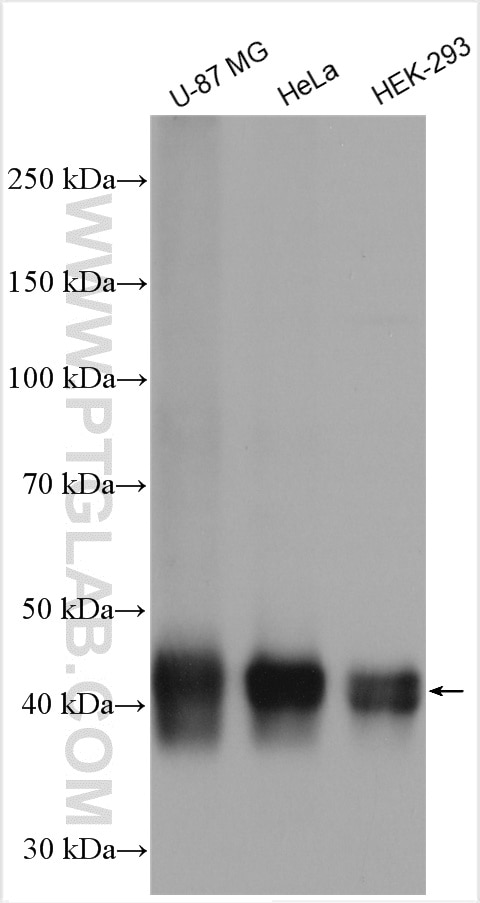- Phare
- Validé par KD/KO
Anticorps Polyclonal de lapin anti-GPR177
GPR177 Polyclonal Antibody for WB, IP, IHC, ELISA
Hôte / Isotype
Lapin / IgG
Réactivité testée
Humain, rat, souris et plus (1)
Applications
WB, IP, IHC, ELISA
Conjugaison
Non conjugué
N° de cat : 17950-1-AP
Synonymes
Galerie de données de validation
Applications testées
| Résultats positifs en WB | cellules MG U-87, cellules HEK-293, tissu cérébral de rat, tissu cérébral de souris |
| Résultats positifs en IP | tissu hépatique de souris |
| Résultats positifs en IHC | tissu ovarien humain, tissu hépatique de souris, tissu rénal humain il est suggéré de démasquer l'antigène avec un tampon de TE buffer pH 9.0; (*) À défaut, 'le démasquage de l'antigène peut être 'effectué avec un tampon citrate pH 6,0. |
Dilution recommandée
| Application | Dilution |
|---|---|
| Western Blot (WB) | WB : 1:1000-1:5000 |
| Immunoprécipitation (IP) | IP : 0.5-4.0 ug for 1.0-3.0 mg of total protein lysate |
| Immunohistochimie (IHC) | IHC : 1:50-1:500 |
| It is recommended that this reagent should be titrated in each testing system to obtain optimal results. | |
| Sample-dependent, check data in validation data gallery | |
Applications publiées
| WB | See 6 publications below |
| IHC | See 4 publications below |
Informations sur le produit
17950-1-AP cible GPR177 dans les applications de WB, IP, IHC, ELISA et montre une réactivité avec des échantillons Humain, rat, souris
| Réactivité | Humain, rat, souris |
| Réactivité citée | rat, Chèvre, Humain, souris |
| Hôte / Isotype | Lapin / IgG |
| Clonalité | Polyclonal |
| Type | Anticorps |
| Immunogène | GPR177 Protéine recombinante Ag12428 |
| Nom complet | G protein-coupled receptor 177 |
| Masse moléculaire calculée | 541 aa, 62 kDa |
| Poids moléculaire observé | 46-65 kDa |
| Numéro d’acquisition GenBank | BC110826 |
| Symbole du gène | GPR177 |
| Identification du gène (NCBI) | 79971 |
| Conjugaison | Non conjugué |
| Forme | Liquide |
| Méthode de purification | Purification par affinité contre l'antigène |
| Tampon de stockage | PBS avec azoture de sodium à 0,02 % et glycérol à 50 % pH 7,3 |
| Conditions de stockage | Stocker à -20°C. Stable pendant un an après l'expédition. L'aliquotage n'est pas nécessaire pour le stockage à -20oC Les 20ul contiennent 0,1% de BSA. |
Informations générales
GPR177, also known as Wntless (WLS) or Evi, is an evolutionarily conserved transmembrane protein necessary for Wnt protein secretion. GPR177 localizes to compartments of the secretory pathway, including the ER, Golgi apparatus, endosomes, and plasma membrane. GPR177 is overexpressed in several cancer types including glioma and gastric cancer. Several isoforms of GPR177 exist due to the alternative splicing, with predicted MW around 62 and 51 kDa, respectively. The sequence can be processed by removing the signal peptide, which generates a mature form of 45-46 kDa. In addition, slow migragrating band above 62 kDa can also be detected because GPR177 is modified by N-linked glycosylation (PMID: 20549736).
Protocole
| Product Specific Protocols | |
|---|---|
| WB protocol for GPR177 antibody 17950-1-AP | Download protocol |
| IHC protocol for GPR177 antibody 17950-1-AP | Download protocol |
| IP protocol for GPR177 antibody 17950-1-AP | Download protocol |
| Standard Protocols | |
|---|---|
| Click here to view our Standard Protocols |
Publications
| Species | Application | Title |
|---|---|---|
Cell Res Comprehensive profiling reveals mechanisms of SOX2-mediated cell fate specification in human ESCs and NPCs. | ||
Front Physiol A Longitudinal Study of T2 Mapping Combined With Diffusion Tensor Imaging to Quantitatively Evaluate Tissue Repair of Rat Skeletal Muscle After Frostbite. | ||
Onco Targets Ther Wntless (Wls): A Prognostic Index for Progression and Patient Survival of Breast Cancer. | ||
Int Ophthalmol The effect of Wnt/β-catenin pathway on the scleral remolding in the mouse during form deprivation. | ||
Cells Integrative Analysis of Methylome and Transcriptome Reveals the Regulatory Mechanisms of Hair Follicle Morphogenesis in Cashmere Goat. |











